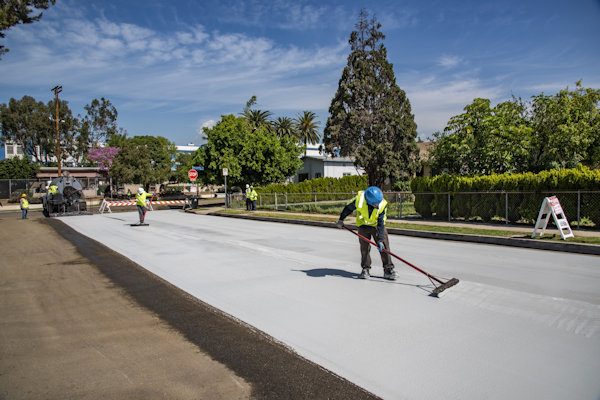SEJournal Online is the digital news magazine of the Society of Environmental Journalists. Learn more about SEJournal Online, including submission, subscription and advertising information.
 |
 |
| Pavement materials that reflect sunlight back into the atmosphere are one tool communities are using to cool temperatures. Above, workers from the Los Angeles Department of Public Works applied a cool slurry to pavement on Marquerite Street as part of its Cool LA initiative. Photo: Bureau of Street Services (StreetsLA). |
TipSheet: What Makes Communities More Survivable in Extreme Heat Events?
By Joseph A. Davis
The United States has already endured at least two killer heat waves this year, and the prospects are for more and for worse. Climate heating will ensure that.
Environmental journalists can
find lots of stories in how local
communities respond to and
prepare for extreme heat.
That means environmental journalists can find lots of stories in how local communities respond to and prepare for extreme heat.
Many news outlets have been running the “drink water and stay indoors” story focusing on short-term individual behaviors. But there are other stories about more permanent measures that can keep people alive.
 |
Why it matters
Extreme heat kills people.
In many cases, heat illness (like heat exhaustion and heat stroke) is a clear cause. In other cases, the stress can cause things like heart failure or kidney failure, which is why heat is not always listed on a death certificate, even if it is a contributing cause.
Also, the summer heat season amps up air pollution — and brings wildfires whose smoke spreads across the continent, harming health.
We know it’s bad because we have been through it before (even if it is getting worse).
Story ideas
- Chief heat officers: Does your city or county have a chief heat officer? If so, talk to them. What do they do, anyway? What’s the plan?
- Cool pavements: Black asphalt absorbs a lot of heat. There are now pavement materials that reflect a lot of sunlight back into the atmosphere, significantly cooling cities. Is there any cool pavement near you? Talk to your public works department.
- Urban trees: Because of the shade they offer, urban trees offer significant relief from extreme heat if there are enough of the right kind. Talk to the department in your municipality that plants trees. Is its budget big enough to plant more? Are there fewer trees in underserved neighborhoods?
- Cooling centers: Some cities open cooling centers during extreme heat. Often they are just public buildings that are air-conditioned — like a school auditorium. If your community has one, who runs it? Talk to them. How early does it open? How long can people stay?
- Grid resiliency: High power demand during heat waves can lead to outages when the capacity of a local or regional grid is insufficient. Talk to your local electric utility about its planning for these events. Talk to your regional grid operator or regional transmission organization about how well prepared they are.
- Public pools: Does your community have public swimming pools — or does it open splash pads in heat events? Visit. Talk to pool managers and patrons. (Photo op!)
- Homeless shelters: People living on the street are especially vulnerable during heat events. Will available shelters take them in? Will they go? Talk to the people who run shelters. Talk to people who are homeless. Bring water.
- Jails and prisons: Is there air conditioning in your local prisons? Texas and Florida, two very hot states, are notorious for their lack of it — but it’s scarce in some other Southern states, too. Talk to your state legislators, prison officials and inmates.
- Drinking fountains: Are there enough drinking fountains in public areas and buildings? Do they work? Do people use them (some think they are unsanitary)? Do people use bottled water instead?
- Schools: In some areas, schools were built without air conditioning because kids are out during the summer. But with school starting earlier and the climate getting hotter, some kids swelter for weeks without AC. What are the problems or plans in your area?
- Building construction: How houses and buildings are constructed makes a difference in heat waves. Adobe houses have been used for millennia to moderate heat, but they don’t work everywhere. Windows, shades, ventilation, insulation, etc., help. What does your local building code say about hot weather building adaptations?
- Infrastructure: In extreme heat, important infrastructure like roads, train rails and bridges may expand and buckle, making them unsafe or closing them down. Talk to civil engineers at local universities or firms about what’s happening near you.
Reporting resources
- Centers for Disease Control and Prevention: The CDC is a good source of expert insight into the public health consequences of extreme heat events. It also contributes to the nifty HeatRisk Map app.
- Health departments: State and local public health agencies are good sources of information about how bad a heat emergency may be getting in terms of casualties.
- American Red Cross: This all-around disaster agency has local chapters that can tell you more about what is going on in your area. It also has all kinds of safety info.
- Adrienne Arsht-Rockefeller Foundation Resilience Center: Arsht-Rock is a funder and organizer that focuses partly on heat wave safety.
- National Integrated Heat Health Information System: NIHHIS is a multi-agency federal clearinghouse aimed at reducing the health, economic and infrastructural impacts of extreme heat.
[Editor’s Note: For more on heat waves and health, see our recent Toolbox on the new HeatRisk data site, TipSheets on extreme temperatures as a local story, on urban heat islands and on heat-induced grid failures, and other Toolboxes on resources for tying temperature shifts to climate change, for finding record temps and for tracking data on heat deaths. Also see our Backgrounder on extreme heat and human health, an EJ InSight on photographing extreme heat waves and a feature on reporting on workers in a warming world. For more on climate change generally, be sure to visit our Climate Change Resource Guide and its collection of resources on human health. Keep track of the latest heat wave-related headlines via EJToday.]
Joseph A. Davis is a freelance writer/editor in Washington, D.C. who has been writing about the environment since 1976. He writes SEJournal Online's TipSheet, Reporter's Toolbox and Issue Backgrounder, and curates SEJ's weekday news headlines service EJToday and @EJTodayNews. Davis also directs SEJ's Freedom of Information Project and writes the WatchDog opinion column.
* From the weekly news magazine SEJournal Online, Vol. 9, No. 26. Content from each new issue of SEJournal Online is available to the public via the SEJournal Online main page. Subscribe to the e-newsletter here. And see past issues of the SEJournal archived here.













 Advertisement
Advertisement 



